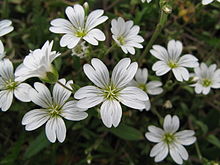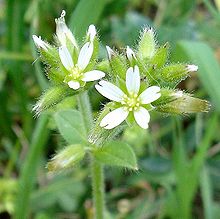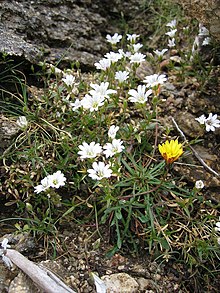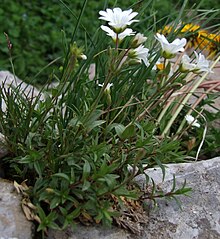Horn herbs
| Horn herbs | ||||||||||||
|---|---|---|---|---|---|---|---|---|---|---|---|---|

Hornwort ( Cerastium uniflorum ) |
||||||||||||
| Systematics | ||||||||||||
|
||||||||||||
| Scientific name | ||||||||||||
| Cerastium | ||||||||||||
| L. |
Cerastium ( Cerastium ) constitute a genus within the family of Caryophyllaceae (Caryophyllaceae). The approximately 100 species are distributed almost worldwide and are mainly found in the temperate to cool areas of the northern hemisphere .
description




Appearance and leaves
Chickweed species are usually one-year or perennial herbaceous plants . There are mostly thin taproots and, in the perennial species, often rhizomes that form roots at the nodes. The independently upright, ascending or lying, simple or branched stems are terete, often hairy and generally evenly leafed.
The leaves are opposite. The simple leaf blades are linear to elliptical or ovate.
Inflorescences and flowers
The flowers are seldom single, mostly in large numbers in mostly terminal, open or dense, zymous inflorescences (dichasias); in Cerastium axillare the inflorescences are lateral and racemose . The paired bracts are leaf-like or reduced, herbaceous or often with dry-skinned margins.
The hermaphrodite flowers are radially symmetrical and usually five-fold with a double flower envelope . The often deeply edged, white petals are characteristic of Cerastium species . Most of the five sepals are free. There are usually five styles, more rarely three, four or six.
The flower formula is:
Fruits and seeds
The name hornwort refers to the capsule fruits , which are usually curved like horns and which have twice as many teeth as pistils. The cylindrical or elongated and often curved capsule fruits contain numerous seeds. The seeds are spherical or kidney-shaped and flattened with a warty seed coat.
Occurrence
The genus Cerastium is distributed almost worldwide, but is particularly numerous in the temperate to cool areas of the northern hemisphere ( Eurasia and North America ). There are 23 species in China, nine of which are only there. There are 27 species in North America.
Some Cerastium species ( e.g. Cerastium subpilosum ) can be found at altitudes of 3900 meters.
Systematics
The genus Cerastium was established by Carl von Linné in Species Plantarum in 1753 , the diagnosis is in Genera Plantarum . The genus Cerastium is derived from the Greek ceras for horn and refers to the shape of the capsule fruit. A synonym for Cerastium L. is Provancheria B. Boivin . The genus Cerastium belongs to the tribe Alsineae in the subfamily Alsinoideae within the family Caryophyllaceae .










There are about 100 species in the genus Cerastium (selection):
- Cerastium aleuticum Hultén : This endemic occurs only in the Aleutian Islands .
- Alpine Hornwort ( Cerastium alpinum L. ): It occurs in Europe , Greenland and Canada .
- Chickweed hornwort ( Cerastium alsinifolium Tausch ): It is endemic to serpentine rock in the northwestern Czech Republic and occurs only on the Wolfstein mountain and on the Rauschenbacher Heide between Sangerberg and Einsiedel (Mnichov) northeast of Marienbad (Mariánské Lázně).
- Cerastium anomalum cabinet
- Cerastium araraticum Rupr. : It occurs only in Anatolia .
- Arctic hornwort ( Cerastium arcticum Lange )
- Cerastium argenteum M.Bieb.
- Cerastium armeniacum Gren. : It occurs only in Anatolia.
- Field hornwort ( Cerastium arvense L. )
- Cerastium atlanticum Durieu : It occurs only in North Africa ( Algeria , Tunisia , Morocco ).
- Cerastium axillare Correll : It occurs in Mexico , New Mexico and Texas .
- Cerastium azoricum Seub. : It only occurs in the Azores .
- Cerastium ballsii Maire : It occurs only in Morocco .
- Cerastium banaticum (Rochel) Heuff. : It occurs in Southeast Europe and the Middle East .
- Cerastium beeringianum Cham. & Schltdl. : It occurs in Asia and North America.
- Cerastium bialynickii Tolmatchew : It occurs on Svalbard , Greenland, Alaska , Arctic Canada and Arctic Asian Russia.
- Bieberstein's Hornwort ( Cerastium biebersteinii DC. ): It is endemic to the Crimea .
- Bearded Hornwort ( Cerastium brachypetalum Pers. ): There are several subspecies.
- Cerastium brachypodum (Engelmann ex A.Gray) BLRobinson : It is found in Canada, the United States and Mexico.
- Pure white hornwort ( Cerastium candidissimum Correns ): It occurs only in Greece .
- Carinthian Hornwort ( Cerastium carinthiacum Vest )
- Hornwort ( Cerastium cerastoides (L.) Britton )
- Cerastium chlorifolium fish. & CAMey. : It occurs only in Anatolia.
- Cerastium comatum Desv. (Syn .: Cerastium illyricum Hayek subsp. Comatum (Desv.) PDSell & Whitehead ): It occurs in Macedonia , Greece, Turkey, Lebanon and Syria , also in Libya, on Corsica and maybe also in Spain.
- Cerastium daghestanicum Shishk.
- Cerastium dahuricum Spreng.
- Cerastium davuricum fish.
- Cerastium decalvans lock. & Vuk. : It occurs only on the Balkan Peninsula and on the Aegean islands.
- Cerastium deschatresii Greuter, N.Böhling & RLJahn is a cleistogamous kind that only Crete found.
- Cerastium dichotomum L .: It occurs in Spain and Greece, in West and Central Asia as well as in Pakistan and North Africa.
- Four-male hornwort ( Cerastium diffusum pers. )
- Dinaric hornwort Cerastium dinaricum Beck & Szyszylł. : It occurs only in Slovenia , Croatia and Albania .
- Cerastium dominici Kit Tan & RRMill : It is only found in Anatolia.
- Sticky hornwort ( Cerastium dubium (Bast.) Guépin )
- Woolly Hornwort ( Cerastium eriophorum Kit. )
- Cerastium fastigiatum Greene : It occurs in Arizona and New Mexico at altitudes from 1900 to 3000 meters.
- Cerastium fischerianum Ser. : It occurs in Asia, Alaska and British Columbia .
-
Spring hornwort ( Cerastium fontanum Baumg. ): There are subspecies (selection):
- Cerastium fontanum Baumg. subsp. fontanum
- Large-fruited hornwort ( Cerastium fontanum subsp. Lucorum (Schur) Soó , Syn .: Cerastium lucorum (Schur) Möschl )
- Common hornwort ( Cerastium fontanum subsp. Vulgare (Hartm.) Greuter & Burdet , Syn .: Cerastium holosteoides Fries , Cerastium caespitosum Gilib. Ex Asch. , Cerastium fontanum subsp. Triviale (Spenn.) Jalas , Cerastium triviale Link , Cerastium vulgare Hartm. , Cerastium vulgatum auct.)
- Cerastium fragillimum Boiss. : It occurs only in Western Asia from the islands of the eastern Aegean to Syria.
- Cerastium gibraltaricum Boiss. : It occurs in southern Spain , Morocco, Algeria, Sardinia and Corsica .
- Hornwort ( Cerastium glomeratum Thuill. , Syn .: Cerastium viscosum auct.): It occurs naturally in large parts of Europe, on Madeira, in North Africa, on the Arabian Peninsula , in West Asia, in the Caucasus , in Turkmenistan and on the Indian subcontinent in front. It is an invasive plant in many areas of the world .
- Cerastium gnaphalodes Fenzl : It occurs only in Anatolia.
- Cerastium gorodkovianum Shishk .
- Cerastium gracile Dufour : It occurs only in southern Europe , North Africa and the Middle East.
- Large-flowered hornwort ( Cerastium grandiflorum Waldst. & Kit. ): It occurs on the western Balkan peninsula from the southern Alps to Albania .
- Cerastium granulatum (Huter, Porta & Rigo) Chiov. : It only occurs in Italy.
- Cerastium haussknechtii Boiss. : It occurs only in Anatolia.
- Cerastium hekuravense Jáv. : It occurs only in the Prokletije in N-Albania.
- Cerastium hemschinicum Shishk .
- Cerastium holosteum Hornem.
- Cerastium illyricum Ard. : It occurs only in Greece, Macedonia, the islands of the Eastern Aegean and Cyprus .
- Cerastium inflatum Gren.
- Julian Hornwort ( Cerastium julicum Schellmann ): This endemic species of the Julian Alps , the Steiner Alps and the eastern Karawanken thrives on limestone rubble and limestone rocks.
- Cerastium Kasbek Parrot
- Cerastium kotschyi Boiss. : It occurs in the Middle East.
- Cerastium lanuginosum Rchb.
- Broad-leaved hornwort ( Cerastium latifolium L. )
- Cerastium lazicum Boiss. : It occurs only in Anatolia.
- Ligurian Hornwort ( Cerastium ligusticum Viv. )
- Piedmontese hornwort ( Cerastium lineare All. ): It occurs only in France and Italy.
- Cerastium longifolium Willd.
- Cerastium macranthum Boiss. : It occurs only in Anatolia.
- Cerastium maximum L .: It occurs in north-western Arctic North America, in the Asian part of Russia and in the Chinese Xinjiang .
- Cerastium microspermum C.A.Mey.
- Cerastium moesiacum Friv. : It occurs only on the Balkan Peninsula and the East Aegean Islands.
- Cerastium multiflorum C.A.Mey.
- Cerastium nemorale M.Bieb.
- Cerastium nigrescens (HCWatson) HCWatson
- Cerastium nutans Rafin. : They are widespread in Canada, the United States, and Mexico.
- Cerastium odessanum Klokov
- Cerastium oreades Shishk.
- Cerastium pauciflorum Ser.
- Cerastium pedunculare Bory & Chaub. : It occurs in Greece.
- Long-stemmed hornwort ( Cerastium pedunculatum Gaudin ): It occurs only in the Alps of France, Switzerland , Italy and Austria .
- Cerastium perfoliatum L.
- Cerastium pisidicum Ayasligil & Kit Tan : It is only found in Anatolia.
- Cerastium polymorphum Rupr.
- Cerastium ponticum Albov
- Cerastium pseudo-kasbek Vysokoostrovskaja
-
Cerastium pumilum Curtis : There are subspecies:
- Pale chickweed ( Cerastium pumilum subsp. Glutinosum (Fr.) Jalas , Syn .: Cerastium glutinosum Fries )
- Dark horn herb ( Cerastium pumilum Curtis subsp. Pumilum )
- Cerastium purpurascens Adams
- Cerastium pusillum Ser. : It occurs in eastern and western Siberia as well as in Central Asia southwards to northern Pakistan .
- Cerastium pyrenaicum J.Gay : It occurs only in the Pyrenees (Spain and France).
- Cerastium qingliangfengicum H.W.Zhang & XFJin : It was first described in 2008 and so far only found at altitudes of around 500 meters in the Chinese province of Zhejiang .
- Cerastium rectum Friv. : It only occurs on the Balkan Peninsula.
- Cerastium regulii Ostenf.
- Cerastium ruderale M.Bieb.
- Cerastium runemarkii Möschl & Rech. F. : It is endemic to the Greek islands of Naxos and Evia.
- Cerastium saccardoanum Diratz. : It occurs only in Anatolia.
- Cerastium salatavicum Rupr.
-
Cerastium scaposum Boiss. & Hero. : It is endemic to Crete, with the subspecies:
- Cerastium scaposum subsp. peninsularum Greuter , N.Böhling & RLJahn
- Cerastium scaposum Boiss. & Hero. subsp. scaposum
- Cerastium scaranii Ten. : It occurs only in Italy and Sicily.
- Cerastium schischkinii Grossh.
- Sand hornwort ( Cerastium semidecandrum L. )
- Cerastium siculum casting. : It occurs only in southern Europe and northern Africa.
- Cerastium smolikanum Hartvig : It occurs only in Greece.
- Cerastium soleirolii Duby : It occurs only in Italy and Corsica.
- Cerastium sosnowskyi Shishk.
- Cerastium subpilosum Hayata (Syn .: Arenaria subpilosa (Hayata) Ohwi , Cerastium taiwanense T.S.Liu ): This endemic thrives in the mountains at altitudes of 300 to 3900 meters only in central Taiwan .
- Isonzo hornwort ( Cerastium subtriflorum (Rchb.) Pacher ): It occurs only in Italy and Slovenia.
- Cerastium svanicum Charadze
- Cerastium sventenii Jalas : It occurs in the Canaries .
- Hornwort ( Cerastium sylvaticum Waldst. & Kit. ): It occurs only in eastern and southern Central Europe, in southern Europe and in eastern Europe
- Cerastium szechuense F.N.Williams : It thrives on grass-covered mountain slopes at altitudes of 2100 to 3500 meters only in the northern and western parts of the Chinese province of Sichuan .
- Cerastium szowitsii Boiss.
- Cerastium takasagomontanum Masamune (Syn .: Arenaria takasagomontana (Masamune) SSYing , Cerastium subpilosum var. Takasagomontanum (Masamune) SSYing ): This endemic thrives on mountain slopes and rocks at altitudes of 2500 to 3400 meters only in central Taiwan.
- Cerastium terrae-novae Fernald & Wiegand : It occurs in Newfoundland and Labrador .
- Cerastium texanum Britton : It occurs in Arizona, New Mexico and Mexico but not in Texas.
- Cerastium theophrasti Merxm. & Strid : She is endemic to Olympus in Greece.
- Cerastium thomasii (Montel.) Ten. : It only occurs in Italy .
- Cerastium thomsonii Hook.f. : It occurs in Afghanistan, Pakistan and the western Himalayas .
- Felty hornwort ( Cerastium tomentosum L. ): The home is Italy and Sicily . It is cultivated worldwide and is naturalized many times.
- Cerastium transsilvanicum Schur : It occurs only in Romania .
- Cerastium undulatifolium Sommier & Levier
- Single-flowered hornwort ( Cerastium uniflorum Clairv. )
- Cerastium uralense Grubov
- Cerastium vagans Lowe : It occurs in the Azores and Madeira .
- Cerastium velutinum Rafin. : It occurs in eastern North America.
- Cerastium verticifolium R.L.Dang & XMPi : It thrives in mountain valleys at altitudes of 1800 to 2000 meters only in the Xinjiang Autonomous Region .
- Cerastium viride A.Heller : It occurs in Oregon and California.
- Cerastium vourinense Möschl & Rech. F. : It only occurs in Greece.
- Cerastium wilsonii Takeda : It thrives on the edges of forests and mountain slopes at altitudes of 1100 to 2000 meters in the Chinese provinces of Anhui , Gansu , Henan , Hubei , southern Shaanxi , Sichuan and Yunnan .
use
As rock garden plants and ground cover, felted hornwort ( Cerastium tomentosum ), but also Bieberstein hornwort ( Cerastium biebersteinii ), pure white hornwort ( Cerastium candidissimum ), field hornwort ( Cerastium arvense ) and large-flowered hornwort ( Cerastium grandiflorum ) are used.
literature
- Manfred A. Fischer, Wolfgang Adler, Karl Oswald: Excursion flora for Austria, Liechtenstein and South Tyrol . 2nd, improved and enlarged edition. State of Upper Austria, Biology Center of the Upper Austrian State Museums, Linz 2005, ISBN 3-85474-140-5 .
- Arvo Jaakko Juhani Jalas, Michael B. Wyse Jackson, Peter Derek Sell, FH Whitehead: Cerastium L. In: TG Tutin, NA Burges, AO Chater, JR Edmondson, VH Heywood, DM Moore, DH Valentine, SM Walters, DA Webb ( Ed.): Flora Europaea . 2nd, revised edition. Volume 1: Psilotaceae to Platanaceae . Cambridge University Press, Cambridge / New York / Melbourne 1993, ISBN 0-521-41007-X , pp. 164–175 (English, limited preview in Google Book Search).
- Lu Dequan, John K. Morton: Cerastium Linnaeus. In: Wu Zhengyi, Peter H. Raven, Deyuan Hong (Eds.): Flora of China . Volume 6: Caryophyllaceae through Lardizabalaceae . Science Press / Missouri Botanical Garden Press, Beijing / St. Louis 2001, ISBN 1-930723-05-9 , pp. 31 (English). , PDF file (sections description and systematics).
- John K. Morton: Cerastium Linnaeus. In: Flora of North America Editorial Committee (Ed.): Flora of North America North of Mexico . Volume 5: Magnoliophyta: Caryophyllidae, part 2 . Oxford University Press, New York / Oxford a. a. 2005, ISBN 0-19-522211-3 , pp. 74–93 (English, limited preview in Google Book Search).
- David Aeschimann, Konrad Lauber, Daniel Martin Moser, Jean-Paul Theurillat: Flora alpina. An atlas of all 4500 vascular plants in the Alps. Volume 1, Haupt, Bern / Stuttgart / Vienna 2004, ISBN 3-258-06600-0 , pp. 292–306.
Individual evidence
- ↑ a b c d e f g h i j k l m Lu Dequan, John K. Morton: Cerastium Linnaeus. In: Wu Zhengyi, Peter H. Raven, Deyuan Hong (Eds.): Flora of China . Volume 6: Caryophyllaceae through Lardizabalaceae . Science Press / Missouri Botanical Garden Press, Beijing / St. Louis 2001, ISBN 1-930723-05-9 , pp. 31 (English). , PDF file .
- ↑ a b c d e f g h i j k l m n o p q John K. Morton: Cerastium Linnaeus. In: Flora of North America Editorial Committee (Ed.): Flora of North America North of Mexico . Volume 5: Magnoliophyta: Caryophyllidae, part 2 . Oxford University Press, New York / Oxford a. a. 2005, ISBN 0-19-522211-3 , pp. 74–93 (English, limited preview in Google Book Search).
- ↑ Carl von Linné: Species Plantarum. Volume 1, Lars Salvius, Stockholm 1753, p. 437, digitized
- ↑ Carl von Linné: Genera plantarum: eorumque characteres naturales secundum numerum, figuram, situm, et proportionem omnium fructificationis partium. Editio quinta. Lars Salvius, Stockholm 1754, p. 199, digitized
- ↑ a b c d e f g h Cerastium in the Germplasm Resources Information Network (GRIN), USDA , ARS , National Genetic Resources Program. National Germplasm Resources Laboratory, Beltsville, Maryland. Retrieved December 21, 2013.
- ↑ a b c d e f g h i j k l m n o p q r s t u v w x y z aa ab ac ad ae af ag ah ai aj ak al am an Karol Marhold: Caryophyllaceae. Cerastium. In: Euro + Med Plantbase - the information resource for Euro-Mediterranean plant diversity. Berlin 2011.
- ↑ Hans-Christian Friedrich: Family Caryophyllaceae . Karl Heinz Rechinger (Hrsg.): Illustrated flora of Central Europe. Pteridophyta, Spermatophyta . Founded by Gustav Hegi. 2nd, completely revised edition. Volume III. Part 2: Angiospermae: Dicotyledones 1 (Phytolaccaceae - Portulacaceae) . Paul Parey, Berlin / Hamburg 1979, ISBN 3-489-60020-7 , pp. 911 (published in deliveries 1959–1979).
- ↑ a b c d Eckehart J. Jäger, Friedrich Ebel, Peter Hanelt, Gerd K. Müller (eds.): Exkursionsflora von Deutschland . Founded by Werner Rothmaler. tape 5 : Herbaceous ornamental and useful plants . Springer, Spektrum Akademischer Verlag, Berlin / Heidelberg 2008, ISBN 978-3-8274-0918-8 , pp. 183-184 .
- ↑ a b c d Werner Greuter, Niels Böhling, Ralf Jahn: The Cerastium scaposum group (Caryophyllaceae): three annual taxa endemic to Crete (Greece), two of them new. In: Willdenowia. Volume 32, No. 1, pp. 45-54, PDF file .
- ↑ Čedomil Šilić 1990: Endemične Biljke. Svjetlost, Sarajevo. Here p. 19
- ↑ Jaakko Jalas, Juha Suominen (ed.): Atlas Florae Europaeae. Distribution of Vascular Plants in Europe. 6. Caryophyllaceae (Alsinoideae and Paronychioideae). Akateeminen Kirjakauppa, The Committee for Mapping the Flora of Europe & Societas Biologica Fennica Vanamo, Helsinki 1983, ISBN 951-9108-05-X , p. 88.
- ↑ Caković D; Stešević D; Fair weather P; Frajman B (2018) Long neglected diversity in the Accursed Mountains of northern Albania: Cerastium hekuravense is genetically and morphologically divergent from C. dinaricum . Plant Syst Evol 304: 57-69
- ^ Manfred A. Fischer, Wolfgang Adler, Karl Oswald: Excursion flora for Austria, Liechtenstein and South Tyrol . 2nd, improved and enlarged edition. Province of Upper Austria, Biology Center of the Upper Austrian State Museums, Linz 2005, ISBN 3-85474-140-5 , p. 329 .
- ^ A b Shahina Ghazanfar: Flora of Pakistan 175: Caryophyllaceae. Department of Botany, University of Karachi, Karachi 1986, Cerastium , p. 35, HTML version at efloras.org.
- ↑ Jaakko Jalas, Juha Suominen (ed.): Atlas Florae Europaeae. Distribution of Vascular Plants in Europe. 6. Caryophyllaceae (Alsinoideae and Paronychioideae). Akateeminen Kirjakauppa, The Committee for Mapping the Flora of Europe & Societas Biologica Fennica Vanamo, Helsinki 1983, ISBN 951-9108-05-X , p. 100.
- ↑ Jaakko Jalas, Juha Suominen (ed.): Atlas Florae Europaeae. Distribution of Vascular Plants in Europe. 6. Caryophyllaceae (Alsinoideae and Paronychioideae). Akateeminen Kirjakauppa, The Committee for Mapping the Flora of Europe & Societas Biologica Fennica Vanamo, Helsinki 1983, ISBN 951-9108-05-X , p. 103.
- ↑ Jaakko Jalas, Juha Suominen (ed.): Atlas Florae Europaeae. Distribution of Vascular Plants in Europe. 6. Caryophyllaceae (Alsinoideae and Paronychioideae). Akateeminen Kirjakauppa, The Committee for Mapping the Flora of Europe & Societas Biologica Fennica Vanamo, Helsinki 1983, ISBN 951-9108-05-X , p. 101.
- ↑ Jaakko Jalas, Juha Suominen (ed.): Atlas Florae Europaeae. Distribution of Vascular Plants in Europe. 6. Caryophyllaceae (Alsinoideae and Paronychioideae). Akateeminen Kirjakauppa, The Committee for Mapping the Flora of Europe & Societas Biologica Fennica Vanamo, Helsinki 1983, ISBN 951-9108-05-X , p. 102.




